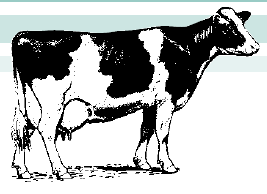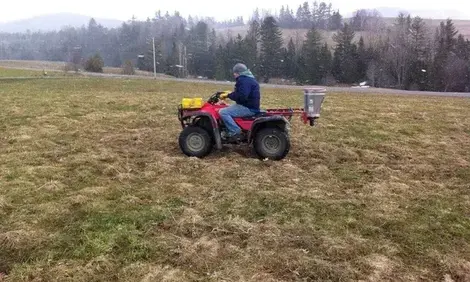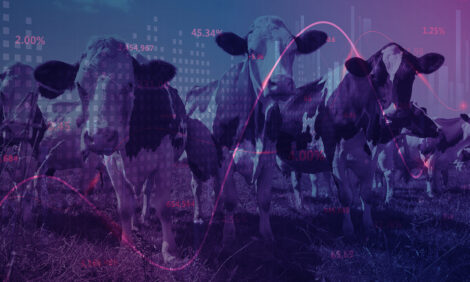



Keeping Cows Cool, Where do I Start?
Heat stress occurs when a dairy cow’s heat load is greater than her capacity to lose heat. Heat stress effects include: increased respiration rate, increased water intake, increased sweating, decrease in dry matter intake, slower rate of feed passage, blood flow to internal organs, milk production and poor reproductive performance, writes JF Smith, JP Harner and MJ Brouk from Kansas University.Water Availability
Providing access to water during heat stress should be the first step. Lactating dairy cattle will typically require between 35 and 45 gallons of water per day. Studies completed in climatic chambers show that water needs increase 1.2 to 2 times when cows are under heat stress (Beede, 1993). A water system needs to be designed to meet both peak demand and daily needs of the dairy. Making water available to cows leaving the milking parlor will increase water intake by cows during heat stress. Access to an 8-foot water trough is adequate for milking parlors with 25 stalls per side. In warmer climates the following formula is used to calculate the required tank perimeter: group size x .15 x 2 = tank perimeter in feet. In cooler climates, one waterer or 2 feet of tank perimeter is adequate for every 15 to 20 cows. An ideal situation would be to have water available at every crossover in freestall housing with 100 feet between crossovers. (Smith et al., 2000 and Midwest Plan Service, 1997).

Shades
Providing shade in housing areas and the holding pen is the second step. Cows housed in drylot or pasture situations should be provided with solid shade. Florida researchers (Roman-Ponce et al., 1977) found that cows housed with shade had higher milk yields and conception rates than non-shaded cows. Natural shading provided by trees is effective, but most often shades are constructed from solid steel or aluminum. Providing 38 to 48 square feet of solid shade per mature dairy cow is adequate to reduce solar radiation. Shades should be constructed at a height of a least 14 feet with a north-south orientation to prevent wet areas from developing under them (Armstrong, 1993). Using a more porous material like shade cloth or snow fence is not as effective as a solid shade. (Kelly, 1958 and Welchert et al., 1965).
Methods to Cool Cows
Different cooling
systems have been tested
in a wide variety of climates
(Armstrong, 1994,
Bray et al., 1994; Brouk et
al., 1999; Igono et al.,
1987; Lin et al., 1998;
Strickland et al., 1989; and
Turner et al., 1992). Researchers
have tried everything
from high-pressure
misters to low- pressure
sprinklers or soakers to
apply water. These have
been used along with fan
systems to aid in the evaporation
of water off the cows'
backs and in the surrounding
air. As humidity in the
environment increases, the
ability to evaporate water
decreases. In general low-pressure
sprinkler or soaker
systems can be used to soak
the cows along with fans in
any climate to cool cows.
The effectiveness of these
systems can be seen by
visiting the local pool on a
hot windy day. Children
will leave the pool and
become cold as the water
evaporates off their skin.
Just watch these children
develop goose bumps as
they search for their towels.
Once they dry off they
become warm and jump
back in the pool to start the
cycle again.
The same technique is
used in cooling dairy cattle
by wetting cows intermittently.
It must be remembered
that high-pressure systems cool the air around
the cow, and work best in
very arid climates. When
low pressure and high-pressure
systems are combined,
the ability to evaporate
moisture off the cows
backs may be reduced.
Unless a dairy is located in
an arid climate, low-pressure
systems are probably
the most economical and
practical way of cooling
cows.
Holding Pen and Exit Lane Cooling
The holding pen is
where dairy cows experience
the most heat stress.
Arizona researchers
(Wiersma and Armstrong
1983) concluded that when
cows were cooled in the
holding pen, milk production
increased 1.7 pounds
per day during the summer.
Low-volume sprinklers and
fans can be used to wet
cows and speed evaporation
of the water off the cows
backs. Fans should operate
continuously providing a
minimum of 1,000 CFM per cow. Fans should be
mounted overhead and
blow downward at a 30
degree angle. Fans of 36-
to 48-inches in diameter are
most common. Fans are
typically placed side by
side spaced 6 to 8 feet
apart. The distance between
rows of fans is 20 feet for
30 and 36-inch fans and
40 feet for 48-inch fans. Water can be sprayed onto
the cows using a PVC grid
of 360 nozzles. Water is
applied one minute out of
every six minutes.
Cooling cows as they
exit the parlor provides an
additional 15 to 25 minutes
of cooling per milking
(Armstrong, 1993). Typically
three to four nozzles
are installed in the exit lane,
with a delivery of approximately
8 gallons of water
per minute at 35 to
40 pounds per square inch.
The nozzles are turned on
and off with an electric eye
or wand switch as the cow
passes under the nozzles. If
properly installed, sprinkler
should wet the top and
sides of the cow , the udder
will remain dry, the water
will not interfere with post-dipping.
FreeStalls
Freestall housing
should be constructed to
provide good natural
ventilation. Sidewalls
should be 14 ft high to
increase the volume of air
in the housing area. The
sidewalls should be open
75 to 100 percent. Fresh air
should be introduced at the
cows' level. Curtains on the
sides of freestall barns
allow grater flexibility in
controlling ventilation.
Because warm air rises,
steeper sloped roofs provide
upward flow of warm
air. However, roofs with slopes steeper than a
6/12 pitch prevent incoming
air from dropping into
the area occupied by the
cows. Roofs with slopes
less than 4/12 may cause
condensation and higher
internal temperatures in the
summer. Roof slopes for
freestall housing should
range from 4/12 to 4/16.
Providing openings in end
walls and alley doors will
improve summer ventilation.
Gable buildings should have a continuous
ridge opening to allow
warm air to escape. The
ridge opening should be
two inches for each 10 feet
of building width. Naturally
ventilated buildings should
be spaced 1.5 to 2 times the
building width (Armstrong
et al., 1999).
Adding fans and a
sprinkler system can provide
additional cooling in
freestall areas. Freestall
bedding must not become
wet. Typically, a sprinkler
system or soaker system
can be located over the
lockups, and fans could be
used over the freestalls,
lockups, or both to aid in
the evaporation of water off
the cows' backs. Water is
applied three minutes out of
a 15-minute cycle. These
spray and fan systems are
turned on and off with a
thermostat at 70-75° F
(Brouk et al., 1999).
Which Groups of Cows Do I Cool First?
A commonly asked question is which cows should be cooled first? Ideally, all lactating and dry cows should be cooled if possible. All lactating cows will respond to cooling during heat stress. But often producers are faced with the reality that they have a limited budget and have to decide which group of cows to cool. The first group to be cooled should be the close-up cows, those within three weeks of calving. Dry matter intake prior to calving is critical to ensure that the up coming lactation is successful. Remember that we typically loose dry matter intake during heat stress. The second group to be cooled should be the fresh and early lactation cows. These cows are establishing the peak milk production of the lactation. For every pound of peak milk production that is lost, 250 pounds of milk production will be lost over that lactation. It is not uncommon for producers in Kansas to lose 10 pounds of peak milk production during heat stress if cows are not cooled. That is equivalent to 2,500 pounds of milk over the lactation. Once the early lactation cows have been cooled, the mid- and late-lactation cows should be cooled. Here is a list of priorities for reducing heat stress:
- Supply adequate water.
- Provide shade in the housing areas (both dry and lactat ing cows) and hold ing pen.
- Reduce walking distance to the parlor.
- Reduce time in the holding pen.
- Improve holding pen ventilation and freestall ventilation.
- Add holding pen cooling and exit lane cooling.
- Cool close-up cows (those within three weeks of calving).
- Cool fresh cow and early-lactation cow housing.
- Cool mid and late lactation cow housing.
Starting with the basics and working overtime to cool all the cows on your dairy will pay big dividends.
References
Armstrong, D.V., P.E.
Hillman, M.J. Meyers, J.F.
Smith, S.R. Stokes and J.P.
Harner III. 1999. Heat Stress
Management in Freestall
Barns in Western United States.
Proceedings of the 1999 Western
Dairy Herd Management
Conference. Las Vegas, NV.
Armstrong, D.V. 1994. Heat
Stress Interaction with Shade
and Cooling. J. Dairy Sci.
77:2044-2050.
Armstrong, D.V. 1993. Environmental
Modifications to
Reduce Heat Stress. Proceedings
of the Western Large Herd
Dairy Management Conference,
Las Vegas, NV, pp. 2-7.
Beede, D.K. 1993. Water
Nutrition and Quality for Dairy
Cattle. Proceedings of the
Western Large Herd Dairy
Management Conference,
Las Vegas, NV, pp. 194-204.
Bray, D.R., R.A. Bucklin, R.
Montoya and R. Gresig. 1994.
Cooling Methods for Dairy
Housing in the Southeastern
United States. Trans. ASAE,
paper no. 94-4501. St. Joseph,
MI.
Brouk, M.J., J.F. Smith, J.P.
Harner III, B.J. Pulkrabek, D.T.
McCarty, and J. E. Shirley.
1999. Performance of Lactating
Dairy Cattle Housed in a
Four-row Freestall Barn
Equipped with Three Different
Cooling Systems. Dairy Day
Report of Progress 842. Kansas
State University, Department
of Animal Sciences, Manhattan,
KS.
Brouk, M.J., J.F. Smith, J.P.
Harner III, B.J. Pulkrabek, D.T.
McCarty, and J.E. Shirley. 1999. Performance of Lactating
Dairy Cattle Housed in
Two-row Freestall Barns
Equipped with Three Different
Cooling Systems. Dairy Day
Report of Progress 842. Kansas
State University, Department
of Animal Sciences, Manhattan,
KS.
Hansen, P.J., W.W. Thatcher,
and A.D. Ealy. 1992. Methods
for Reducing Effects of Heat
Stress on Pregnancy. Large
Herd Dairy Management.
(Van Horn, H.H. and C.J.
Wilcox ed.):116.
Igono, M.O., H.D. Johnson,
B.J. Stevens, G.F. Krause and
M.D. Shanklin, 1987. Physiological,
Productive and Economic
Benefits of Shade, Spray and
Fan Systems vs. Shade for
Holstein Cows During Summer
Heat. J. Dairy Sci. 70:1069-
1079.
Kelly, D.V. and T.E. Bond.
1958. Effectiveness of Artificial
Shade Material. Agr. Eng.
39:758.
Lin., J.C., B.R. Moss, J.L.
Koon, C.A. Flood, R.C. Smith III,
K.A. Cummins and D.A.
Coleman. 1998. Comparison
of Various Fan, Sprinkler, and
Mister Systems in Reducing
Heat Stress in Dairy Cattle.
Appl. Eng. Agric, 14(2):177-
182.
Midwest Plan Service. 1997.
Dairy Freestall Housing and
Equipment. MWPS-7, Sixth
Edition. Agricultural and
Biosystems Engineering Department,
Iowa State University,
Ames, IA 20011-3080.
Roman-Ponce, H., W.W.
Thatcher, D.E. Buffington, C.J.
Wilcox and H.H. VanHorn.
1997. Physiological and Production
Responses of Dairy
Cattle to a Shade Structure in
a Subtropical Environment. J.
Dairy Sci. 60:424.
Smith, J.F., J.P. Harner III,
M.J. Brouk, D.V. Armstrong,
M.J. Gamroth and M.J. Meyer.
2000. Relocation and Expansion
Planning for Dairy Producers.
Kansas State University
Agricultural Experiment Station
and Cooperative Extension
Service. MF2424: 1-20.
Strickland, J.T., R.A. Bucklin,
R.A. Nordstedt, D.K. Beede
and D.R Bray. 1989. Sprinkler
and Fan Cooling Systems for
Dairy Cows in Hot, Humid Climates.
Appl. Eng. Agric. 5(2):
231-326.
Turner, L.W. 1998. Fan and
High-pressure Mist (fog) Systems
Performance for Cooling
Lactating Dairy Cows. Proc.
4th Internatl. Dairy Housing
Conf., St. Joseph, MI. ASAE
201-208.
Welchert, W.T., F. Wiersma,
G.H. Stott, and F. Rollins. 1965.
Hot Weather Relief Methods
for Livestock Production.
A.S.A.E. Paper No. 65-4015. St.
Joseph, MI.
Wiersma, F. and D.V.
Armstrong. 1983. Cooling
Dairy Cattle in the Holding
Pen. A.S.A.E. Paper No. 83-
4507, St. Joseph, MI.
June 2012


